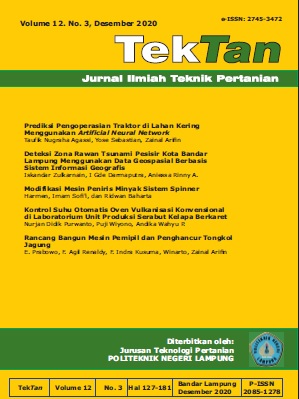Prediksi Pengoperasian Traktor di Lahan Kering Menggunakan Artificial Neural Network
DOI:
https://doi.org/10.25181/tektan.v12i3.1932Keywords:
Artificial Neural Network (ANN), prediction of tractor operation, soil water contentAbstract
Soil water content is an important parameter in making a decision to use a tractor or not. The process of measuring soil water content and levels of field capacity in conventional which takes a long time and cannot be used in real-time to measure it is a major problem in the field. Determinants of soil water content such as ambient temperature, humidity, and rainfall can be obtained easily and quickly either by using a tool or retrieving data from the nearest BMKG station. The objective of this research is to obtain the most optimal prediction model in making decisions about tractor operation in dry land. This research uses an Artificial Neural Network (ANN) in modeling predictions of tractor operation. Prediction of tractor operation is a prediction of tractor use on a certain day using input data obtained before the day of tractor use. ANN modeling uses the back-propagation supervised learning method. The best ANN model used four hidden neurons with a learning coefficient of 0.2, a momentum of 0.8 and 20,000 iterations. This model has been able to provide optimal predictions with an accuracy value of 77%. The ANN model has been successful in predicting tractor operation on dry land using the back-propagation supervised learning method.Downloads
References
Adinugroho S and Sari Y A. 2018. Implementasi Data Mining Menggunakan WEKA. Malang : UB Press.
Baldoncini M, Albéri M, Bottardi C, Chiarelli E, Raptis K G C, Strati V, dan Mantovani F. 2018. Investigating The Potentialities of Monte Carlo Simulation for Assessing Soil Water Content via Proximal Gamma-Ray Spectroscopy. Journal of Environmental Radioactivity 192 105–116.
Brahimi T, Alhebshi F, Alnabilsi H, Bensenouci A, dan Rahman M. 2019. Prediction of Wind Speed Distribution Using Artificial Neural Network: The Case of Saudi Arabia. Procedia Computer Science 163 41–48. Haridjaja O, Baskoro D P T, dan Setianingsih M. 2013. Perbedaan Nilai Kadar Air Kapasitas Lapang Berdasarkan Metode Alhricks, Drainase Bebas, dan Pressure Plate Pada Berbagai Tekstur Tanah dan Hubungannya dengan Pertumbuhan Bunga Matahari (Helianthus annuus L.). Jurnal ilmu Tanah dan Lingkungan, 15 52-59.
Heaton J. 2012. Introduction to The Math of Neural Networks. UK : Heaton Research Inc Naik A dan Samant L. 2016. Correlation Review of Classification Algorithm Using Data Mining Tool: Weka, Rapidminer, Tanagra, Orange And Knime. Procedia Computer Science 85 662 – 668.
Nurhayati dan Aminuddin J. 2016. Pengaruh Kecepatan Angin Terhadap Evapotranspirasi Berdasarkan Metode Penman Di Kebun Stroberi Purbalingga. Journal of Islamic Science and Technology 2 21-28.
Soulis K X dan Elmaloglou S. 2018. Optimum Soil Water Content Sensors Placement For Surface Drip Irrigation Scheduling In Layered soils. Computers and Electronics in Agriculture 152 1–8.
Sulistyono E dan Abdillah R. 2017. Kadar Air Kapasitas Lapang dan Bobot Jenis Tanah yang Optimal untuk Pertumbuhan dan Produksi Umbi Uwi (Dioscorea alataL). Jurnal Agroekoteknologi AGROVIGOR 10 39-43.
Taghavifar H, Mardani A, dan Hosseinloo A H. 2015. Appraisal of artificial neural network-genetic algorithm based model for prediction of the power provided by the agricultural tractors. J. Energy 93 1704-1710.
Taylor M. 2017. Neural Networks : A Visual Introduction for Beginners. Canada : Blue Windmill Media.
Topuz A. 2010. Predicting Moisture Content of Agricultural Products Using Artificial Neural Networks. Advances in Engineering Software 41 464–470.
Ushada M, Okayama T, Suyantohadi A, Khuriyati N, dan Murase H. 2015. Daily Worker Evaluation Model for SME-Scale Food Production System using Kansei Engineering and Artificial Neural Network. Agriculture and Agricultural Science Procedia 3 84 – 88.
Yadav A K, Malik H, dan Chandel S S. 2014. Selection Of Most Relevant Input Parameters Using Weka For Artificial Neural Network Based Solar Radiation Prediction Models. Renewable and Sustainable Energy Reviews 31 509–519.



